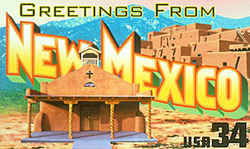


New Mexico Symbols
New Mexico Early History
First Early Inhabitants of New Mexico

Early history examines the archaeological record that tells the story of the first inhabitants of New Mexico. Learn about the prehistory and culture of the first early inhabitants, and what lessons it might teach us about the early history of New Mexico.
About 9200 BCE, the Native Americans are likely present in the area now known as New Mexico. The hunter-gatherer Clovis culture, likely persisting for about 500 years, hunts big game in the region. The Folsom replace the Clovis around 8200 BCE, who are in turn replaced by various pre-historic desert cultures that gradually develop agricultural skills, pottery making, and fine basket weaving. During 700-1300 CE, the modern Pueblo (a Spanish word meaning "villages") have evolved from their more primitive forebears. They primarily live along the area's few rivers, such as the Rio Grande and the Pecos. Here they build adobe houses and further develop agricultural practices. The Great Pueblo of 1050 to 1300 construct irrigation and road systems and build multi-story dwellings in small settlements. In the 1200s, semi-nomadic Apaches and Navajo, both Southern Athabaskan tribes, are present in the region. They trade with Pueblos, and the process becomes important to both groups. Today the Navajo represent the largest tribe in the U.S., living in northwestern New Mexico and northeastern Arizona.
New Mexico First Early Inhabitants Timeline
- c. 25000 BC - Sandia people leave earliest evidence of human existence in what is now New Mexico.
- c. 10000 - 9000 BC - Clovis hunters roam area in search of mammoth, bison and other game.
- c. 9000 - 8000 BC - Folsom people flourish throughout Southwest at the end of the last Ice Age.
- c. 10000 - 500 BC - Cochise people are first inhabitants to cultivate corn, squash and beans, the earliest evidence of agriculture in the Southwest.
- 7000 BC - Archaic Period in which people built basic shelters and made stone weapons and stone tools
- 2000 BC - Pecos Culture begins with changes in architecture, art and pottery for the people who lived in a semi-arid environment
- AD 300 - 1400 - Mogollon culture introduces highly artistic pottery and early architecture in the form of pit houses.
- AD 1 - 700 - Anasazi basket makers elevate weaving to a high art, creating baskets, clothing, sandals and utensils.
- AD 700 - 1300 - Anasazi culture culminates in the highly developed Chaco Civilization.
- AD 1200 - 1500s - Pueblo Indians establish villages along the Rio Grande and its tributaries.
- 1540 - The Tiguex War was the first war between Europeans and Native American Indians. The battles were fought by the army of Francisco Vasquez de Coronado against the Tiwa Indians in New Mexico
- 1680 - 1692: The Pueblo Revolt was located in New Mexico and Arizona between the Native Americans and the Spanish. This was an initial great victory for the Pueblo but the Spanish re-conquered the lands in 1692
Early History of Native Americans in New Mexico
The Indigenous People of New Mexico
The names of the New Mexico tribes included the Apache, Comanche, Jemez, Kiowa, Manso, Navaho, Pecos, Ute, Pueblo and Zuni.
The Clovis-Paleo Indians later discovered the eastern plains of New Mexico, the same expansive romping grounds of the dinosaurs around 10,000 BC The river valleys west of their hunting grounds later flooded with refugees from the declining Four Corners Anasazi cultures.
Sometime between AD 1130 and 1180, the Anasazi drifted from their high-walled towns to evolve into today's Pueblo Indians, so named by early Spanish explorers because they lived in land-based communities much like the villages, or pueblos, of home. Culturally similar American Indians, the Mogollon, lived in today's Gila National Forest.
The Anasazi occupied the region where present day Arizona, New Mexico and Colorado meet. They were among the most highly civilized of the Native
American cultures. They raised corn and cotton, and tamed wild turkeys, using the meat for food and the feathers for clothing. In the winter, the Anasazi
wore garments fashioned from turkey feathers.
The Anasazi were cliff dwellers and built many apartment houses out of closely fitted stones. One such building, the Pueblo Bonito, had nearly 800
rooms.
Around 1500 AD, the Navaho and Apache tribes came to the New Mexico region from the north. Utes and Comanches entered the area a few years later.





